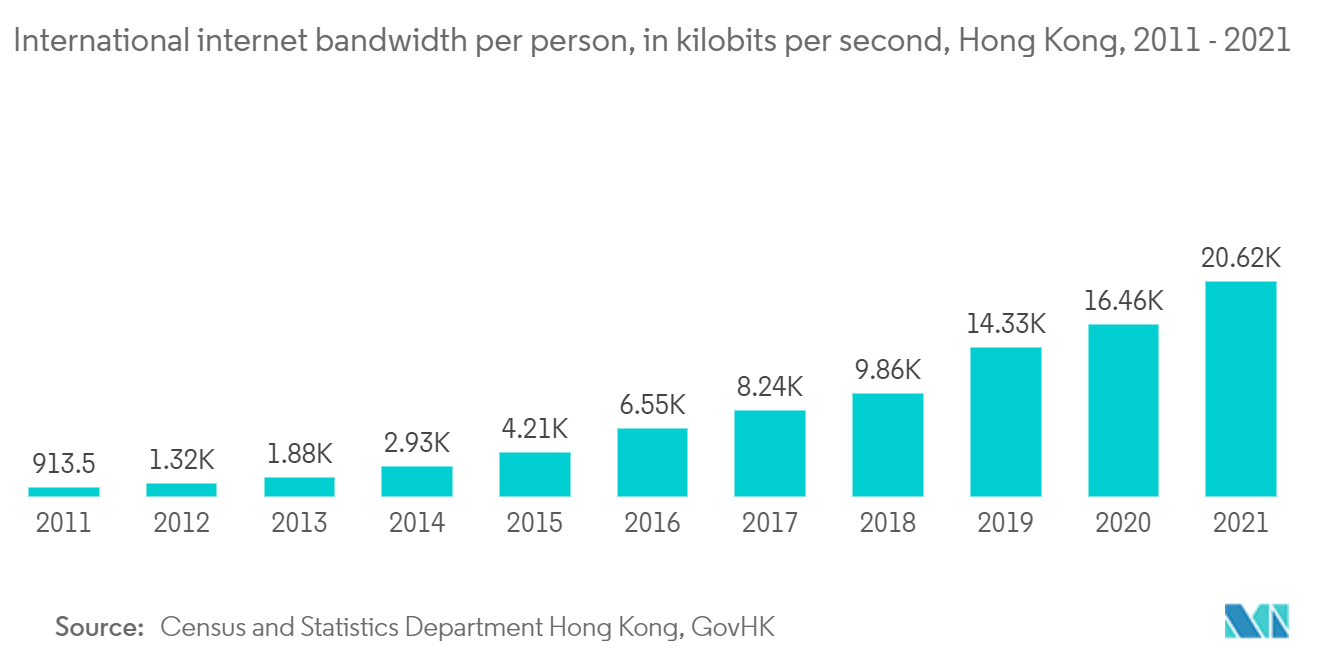Market Trends of Hong Kong Cybersecurity Industry
This section covers the major market trends shaping the Hong Kong Cybersecurity Market according to our research experts:
Increasing Demand for Digitalization, Internet and Scalable IT Infrastructure drive the Hong Kong Cybersecurity Market
- While rapid digitization has made lives easier, it has also raised cyber threats. While using the apps, they generate a large volume of data that must be protected. Hackers might intercept data as personal data and information travel through the internet. If they get this sensitive and personal information, it can be misused.
- The cyber-attacks have increased as internet use increases across the country. According to the World Bank, internet users in Hong Kong accounted for 92.4 percent of the country's population in 2020, 91.7 percent in 2019, and 90.5 percent in 2018. According to a survey by the Thales group, In 2021, 47% of global respondents indicated concern about security threats connected to quantum computing.
- Regarding geographical breakdown, Hong Kong, with 55%, stated being most concerned. Quantum computing rests on quantum mechanics and can be used to conduct virtual experiments and other complex problems that present computers cannot solve. Cybersecurity researchers worry that this computer could potentially break most modern cryptography and pose a serious security risk.
- According to a survey conducted by the government of Hong Kong, in 2021, the international internet bandwidth per person in Hong Kong was 20,623.2 kilobits per second, an over 4,000 kilobits per second increase from the previous year. The international internet bandwidth is an indicator of data transmission speed between different countries.
- Furthermore, in 2021 the number of Personal computers at home connected to the internet in Hong Kong from 2012 to 2021 has increased gradually. In 2021, approximately 2.04 million households in Hong Kong had computers connected to the internet. As the use of the internet increases, cybersecurity needs to increase.

Increase in Cyber attacks in Hong Kong Propel the Use of Cybersecurity Solutions amongst Enterprises
- Hong Kong Computer Emergency Response Team (HKCERT23) reviewed Hong Kong's information security environment in 2021 and a forecast for 2022. Phishing events accounted for 3,737 (48%) of the 7,725 security issues addressed in 2021. The number of phishing occurrences climbed by 7% from 2020, continuing a four-year upward trend and reaching a new high. HKCERT advised individuals and companies of the significant information security concerns in 2022, including Metaverse security issues, Non-fungible tokens (NFT), cryptocurrencies, developing technologies, supply chain assaults, and targeted and orchestrated cyber attacks.
- According to a survey conducted by HKCERT, the total number of reported computer security incidents in Hong Kong from 2007 to 2018 increased gradually, and later from 2019 to 2021, it decreased. In 2021, around 7,738 information security incidents were reported in Hong Kong, a decrease from 8,357 reports in the previous year.
- Although cybercriminals will continue to use tried and proven tactics such as phishing emails, unprotected secrets, and exploiting known vulnerabilities, they will also experiment with new technologies such as Java, Adobe Flash, and WebLogic.
- Hackers have used Malware such as Odinaff, Danabot, Backswap, and Camubot to attack banks that use the SWIFT network to convey money-moving messages. The most important revenue possibilities for the Defense/Government cybersecurity industry include expanding government data privacy laws, more cyber threats, and an increasing number of data centers.
- Targeting the software supply chain allows cybercriminals to extend their victim pool and accelerate attacks. Several attack vectors exist during the software development lifecycle: from contributing open source code to building and testing, then deployment and staging in different pre-production settings, and ultimately deployment to a production environment. Developers use various tools and services throughout this lifespan, increasing the attack surface. Furthermore, because DevOps pipelines hold the keys to the castle, attackers are likelier to target popular development tools such as Kubernetes to remain undetected while compromising many levels of an enterprise's network.


